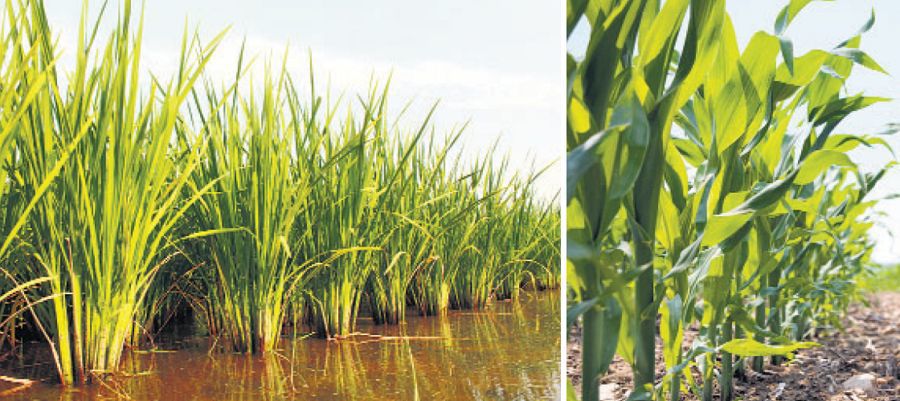Wean farmers off water-guzzling paddy, spring maize

Efforts to diversify crops in Punjab, Haryana, and western Uttar Pradesh face challenges despite decades of advocacy. The region’s reliance on rice and wheat persists, straining groundwater. Spring maize’s popularity exacerbates water usage issues. To encourage diversification, a multi-pronged approach is proposed: expanding niche crops, promoting high-density fruit orchards, and revising subsidy policies. These measures aim to reduce reliance on water-intensive crops and ensure sustainable agricultural practices.
CROP diversification has been advocated in the food bowl of the country for the past two decades, but with little success. Punjab, Haryana and western Uttar Pradesh have been dominant rice- and wheat-growing states/areas since the onset of the Green Revolution. The region was chosen for the purpose due to the potential for assured irrigation and fertile alluvial plains, along with a hardworking and highly responsive peasantry. The Green Revolution, which was aimed at ensuring the food security of the nation, is still catering to the food needs of people, more so during the drought years. The area under paddy in Punjab has increased from 11.8 lakh hectares in 1980-81 to 31.7 lakh hectares in 2022-23. Haryana has witnessed an increase in the area under paddy by 3.2 times during the same period. The area under other kharif season crops has declined. The large area under paddy, coupled with early transplanting and long-duration cultivars, has played havoc with the groundwater resources in the region.
Also a cause for concern is the increasing area under spring maize, another water-guzzling crop in the region. The increasing area under the crop is due to an increase in the number of private silage-preparing plants in the region in the past few years. Punjab witnessed an increase in area under spring maize from 44,000 hectares in 2022 to 1 lakh hectares in 2023 and is expected to be still higher this year. Many farmers growing muskmelon in Jalandhar and Kapurthala districts shifted to spring maize in recent years. High evaporative demand from March to June compels farmers to irrigate the crop every third day. Moreover, the amount of water per irrigation is at least three times higher than that applied to paddy.

Advising the state and/or farmers to shun paddy or reduce area under it, with no alternative and economically equivalent crop in sight, or a no-paddy procurement policy by the state is like groping in the dark. A mechanism needs to be devised so that crop diversification may happen on its own. The best possible mechanism is to plan a multi-pronged strategy with an aim to decreasing the area under water-guzzling paddy and spring maize crops by expanding coverage of alternative niche crops, increasing the cropping system irrigation water efficiency for higher productivity of alternative kharif season crops.

Expanding area under niche crops: Certain alternative crops are being grown in pockets of Punjab, including groundnut, desi maize, celery, spring moong, chickpea, mash, peas and berseem seed.
- Machinery for groundnut digging, threshing, drying, etc. needs to be developed to meet Punjab’s kernel requirement of 4.5 tonnes/day, which is presently being imported from other states.
- The yield improvement of desi maize germplasm, coupled with improving the shelf life of flour, could lead to an increase in its demand, and hence its area in the region. Maize-specific flour mills (replicating the old water mills) need to be developed.
- Better varieties of celery and a processing industry for extraction of oil and oleoresin from celery could increase its demand and area of cultivation.
- The summer moong crop grown after potato has higher productivity and is economically better than spring maize, provided it is procured at the minimum support price. This requires the establishment of markets for moong in potato belts of Punjab and Haryana, on the pattern of the Jagraon market.
- Chickpea areas in Abohar and Khuian Sarvar blocks can be expanded to areas with inadequate canal water supply.
- Mash productivity needs to be improved with the evolution of high-yielding varieties to expand the areas in Pathankot, Dhar Kalan and Kadian blocks.
- To meet the demand for 72,000 quintals of berseem seed, the state should set up systematic seed production, certification and marketing linkages.
- Pea processing industry (freezing and packing) should be established in pea-growing areas of Hoshiarpur and Tarn Taran districts. Apart from mono-picking varietal development, a small pea harvester should be developed and provided through custom hiring. This will serve the dual purpose of price stabilisation and an increase in the area under peas.
- Early maturing turmeric varieties with high curcumin content needs to be developed for expanding the area in niche areas of Hoshiarpur-II, Bhunga and Bhogpur blocks.
- High-quality basmati cultivars having higher productivity and better fragrance, along with integrated nutrient and pest management, can fetch better prices in international markets.
It is very important that a consortia of growers, traders and industrialists be constituted for every niche crop at the state, regional and national levels, apart from establishing localised markets for better profitability.
High-density planting of fruit trees: Shifting from traditional to high-density orchards, coupled with micro-irrigation, can prove to be a better alternative to the rice-wheat system. These orchards are popular among farmers of Himachal Pradesh, Jammu & Kashmir and Uttarakhand due to better profitability, higher amount of A-grade fruit compared to traditional orchards and 4-6 times higher yields. High-density planting of fruit crops like guava, pear, mango and litchi has vast scope in Punjab and Haryana. However, policy support by state governments is a must to encourage and increase area under high-density planting of fruit trees.
- Regular supply of electricity for efficient working of the drip system in high-density orchards must be ensured.
- The existing subsidy policy in northwestern states for small machinery and equipment needs to be revised in the light of present-day needs of such orchards.
- A policy needs to be framed by state governments to divert MGNREGA labour to these orchards at the rate of three persons per acre per year.
- The government policy to provide limited subsidy on liquid fertilisers (with a ceiling on land and amount of subsidy) needs to be reviewed for such orchard farmers.
The above steps need to be amalgamated into a state policy for crop diversification to be self-propelled. However, the targets need to be fixed with specific timelines.
Source Link: https://www.tribuneindia.com/news/features/wean-farmers-off-water-guzzling-paddy-spring-maize-620761

















